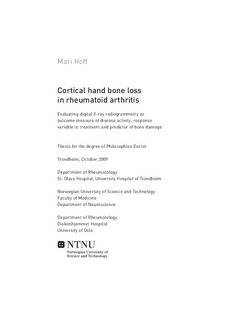Cortical hand bone loss in rheumatoid arthritis: Evaluating digital X-ray radiogrammetry as outcome measure of disease activity, response variable to treatment and predictor of bone damage
Doctoral thesis
Permanent lenke
http://hdl.handle.net/11250/264028Utgivelsesdato
2009Metadata
Vis full innførselSamlinger
Sammendrag
Cortical hand bone loss in rheumatoid arthritis Evaluating digital X-ray radiogrammetry as outcome measure of disease activity, response variable to treatment and predictor of bone damage
Background and objective
Rheumatoid arthritis (RA) is a chronic, systemic inflammatory disease characterised by destruction of joints. The outcome in RA is heterogeneous, and it is important to select the patients with high risk for serious bone damage in the joints early in the disease course. New treatment with biologic agents has the ability to halter this damage, the most used agents block anti-tumour necrosis factor alpha (anti-TNF therapy). There exist no simple tests that can predict the progression in the individual patient. The gold standard is to evaluate the joint destruction (erosions) on radiographs of the hands. Periarticular osteoporosis is a sign that may appear before the erosions, however can not be quantified based on the visual impressions seen on radiographs.
The objective of this doctoral thesis was to evaluate the value of a new method of measuring periarticular osteoporosis to assess disease activity and prognosis in RA patients.
Methods
Periarticular osteoporosis was measured by digital X-ray radiogrammetry (DXR) which measures cortical bone mineral density (BMD) and cortical ratio (MCI) from radiographs of the hands. The computer calculates DXR in a defined area in the metacarpal bones 2-4. This thesis consists of four papers: Two longitudinal observational studies (Paper 1 and 2), one blinded randomised study (Paper 3) and one study evaluating the precision of the DXR method (Paper 4).
Results
Paper 1 included 215 patients followed for two years. In this study DXR was compared to the gold standard for measuring BMD: Dual energy X-ray absorptiometry (DXA). Loss of cortical bone measured by DXR was influenced by disease activity, while DXA-BMD loss was not. DXA-BMD loss was only found in a subgroup with short disease duration (<3years).
Paper 2 was a 10-year observational study in 136 RA patients with disease duration ≤4 years. The patients who lost DXR the first year of follow-up had a greater joint damage on radiographs both after 5 and 10 years, even when corrected for the present most used predictors: Positive rheumatoid factor (anti-CCP), high inflammation measured by C-reactive protein and presence of erosions on radiographs.
Paper 3 was a 2-year double blind, randomised study of 768 patients with RA evaluating the effect of anti-TNF therapy on hand bone. The patients were divided in three treatment groups: Methotrexate (MTX), anti-TNF therapy (adalimumab) or a combination of these. The combination group lost less hand bone, the anti-TNF therapy monotherapy group lost more and the MTX group lost most hand bone. The order of hand bone loss across the three treatment groups was similar to the order of radiographic progression.
Paper 4 evaluated the precision of DXR. A satisfying precision of 0.14-0.46 was found dependent of the radiographic equipment.
Conclusions
Hand bone loss measured by DXR is a feasible and precise method. It is influenced by disease activity, treatment with anti-TNF therapy and can predict subsequent radiographic bone damage. This thesis support that DXR has the potential to be a useful tool evaluating the disease severity in the individual RA patients.
